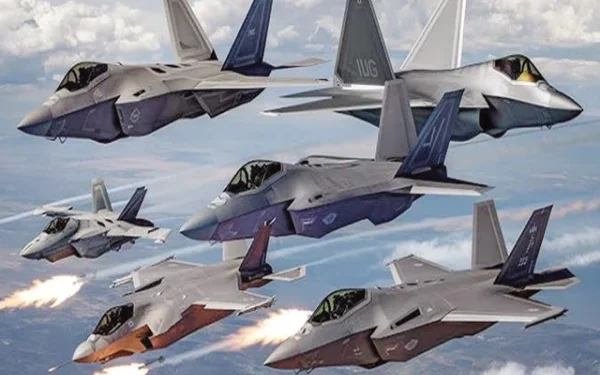Islamabad – In a significant development in global military dynamics, Pakistan is reportedly seeking to strengthen its aerial defense capabilities by acquiring the latest fifth-generation stealth fighter aircraft — the Chinese-made J-35A. This move signals a major leap in the Pakistan Air Force’s modernization drive and underlines Islamabad’s strategic defense cooperation with Beijing.
According to sources in defense and strategic circles, the deal is under consideration as part of Pakistan’s long-term plan to upgrade its air force with state-of-the-art technologies that can match regional threats and challenges. The acquisition of the J-35A, a cutting-edge multi-role stealth fighter, would not only enhance Pakistan’s air superiority but also deepen its military ties with China.
What Is the J-35A? A New Generation of Air Superiority
The J-35A, also known as the FC-31, is China’s second fifth-generation stealth fighter after the J-20. Developed by the Shenyang Aircraft Corporation, the J-35A is designed for advanced multi-role missions including air-to-air combat, precision strikes, and electronic warfare. It is also believed to be carrier-capable, which further extends its strategic value.
The J-35A incorporates several features typically associated with fifth-generation fighter jets, such as:
- Stealth technology to evade radar detection,
- Supersonic cruising speeds,
- Advanced avionics and integrated sensors,
- Situational awareness systems using artificial intelligence and data fusion,
- C3 capabilities (Command, Control, and Communication),
- And network-centric warfare systems for coordinated battlefield responses.
This aircraft is still relatively new and rare in the global defense market, making it a significant asset for any air force seeking to stay ahead in aerial warfare.
Fifth-Generation Fighters: A Club of Global Military Powers
The development and deployment of fifth-generation fighter aircraft remain a privilege of a select group of military powers. Currently, only three countries have successfully developed and operationalized such advanced aircraft:
- United States: F-22 Raptor and F-35 Lightning II
- Russia: Sukhoi Su-57
- China: J-20 and now the J-35A
These aircraft dominate the skies with unmatched capabilities in stealth, speed, electronic warfare, and interoperability. Pakistan’s potential acquisition of the J-35A would place it among the very few nations equipped with fifth-generation warplanes, changing the balance of power in the South Asian region.
Pakistan’s Current Air Fleet and the Need for Modernization
The Pakistan Air Force (PAF) currently operates a mix of fighter aircraft, including:
- F-16 Fighting Falcons (acquired from the U.S.),
- JF-17 Thunder (a joint production with China),
- Dassault Mirage III/V (French-origin),
- F-7s (Chinese MiG-21 variants).
While these aircraft have served Pakistan well over the years, most of them belong to the third or fourth generation. The regional security environment, especially vis-à-vis India’s growing air power and its acquisition of Rafale fighter jets from France, has pushed Pakistan to explore more advanced options.
The induction of a fifth-generation stealth fighter like the J-35A is considered a strategic necessity to maintain air parity and deterrence capabilities in the region.
Strategic Partnership with China: A Foundation of Defense Ties
Pakistan and China share a deep-rooted defense and strategic relationship spanning several decades. From the co-development of the JF-17 Thunder fighter jet to frequent joint military exercises, the two countries have collaborated extensively in the defense sector.
China has become Pakistan’s primary arms supplier following restrictions on Western defense sales. The proposed procurement of the J-35A fits into this longstanding partnership, reflecting mutual trust and shared geopolitical interests.
Moreover, the acquisition would likely include technology transfer, pilot training, and potentially localized maintenance infrastructure, further enhancing Pakistan’s self-reliance in military operations.
Regional Implications and Strategic Significance
The possible inclusion of the J-35A in Pakistan’s fleet would have major implications for regional security. India, Pakistan’s primary rival, is in the midst of modernizing its air force with 36 Rafale fighters and has long-term plans for its own fifth-generation Advanced Medium Combat Aircraft (AMCA) project.
If Pakistan acquires the J-35A ahead of India’s AMCA becoming operational, it could neutralize India’s air advantage, particularly in stealth and electronic warfare domains.
Additionally, the move could:
- Deter aggression along sensitive borders,
- Strengthen Pakistan’s capability in multi-domain operations,
- And enhance its role in regional alliances, such as the China–Pakistan Economic Corridor (CPEC) security.
J-35A vs Competitors: How It Stands Out
While details about the J-35A’s exact specifications remain limited due to military secrecy, defense analysts believe it rivals or even surpasses some existing fifth-generation fighters in certain areas. Here is a comparative overview:
| Feature | J-35A (China) | F-35 (USA) | Su-57 (Russia) |
|---|---|---|---|
| Stealth | High | High | Moderate |
| Speed | Approx Mach 1.8 | Mach 1.6 | Mach 2.0 |
| Avionics | Advanced Chinese systems | Most advanced globally | Advanced |
| Cost | Estimated $70-80M | Over $100M | Estimated $50-70M |
| Multirole Capability | Yes | Yes | Yes |
| Carrier-capable | Yes | Yes (F-35B/C) | No |
From this comparison, the J-35A offers a cost-effective and powerful alternative, especially for countries outside Western alliances.
Potential Challenges in Acquisition
Despite the promise of superior capabilities, Pakistan’s acquisition of the J-35A may face some hurdles:
- Financial constraints: Advanced fighter jets are expensive, not just in procurement but also in maintenance and lifecycle costs.
- Training requirements: The transition to a fifth-generation platform requires intense training for both pilots and ground crews.
- Integration with existing systems: Ensuring seamless integration with Pakistan’s existing air command and control systems could be complex.
- Regional arms race concerns: Such a move may escalate an arms race in South Asia, prompting countermeasures from India and others.
Nonetheless, these challenges may be addressed through phased procurement, financial aid from China, or structured defense agreements.
Conclusion: A Bold Move Toward Future Warfare
Pakistan’s interest in acquiring the J-35A stealth fighter marks a defining step toward transforming its air combat capabilities in an increasingly contested region. If finalized, this deal could reposition the Pakistan Air Force among the few air forces in the world operating fifth-generation fighters — a remarkable milestone in its history.
As the global military landscape evolves, air superiority remains a cornerstone of national defense. By turning to China’s J-35A, Pakistan is not just acquiring a new aircraft — it is investing in technological parity, strategic deterrence, and a deeper defense alliance with a global power.
Whether this leads to a reshaping of South Asia’s military equilibrium remains to be seen, but it undoubtedly places Pakistan on a new trajectory in aerial warfare readiness.

























